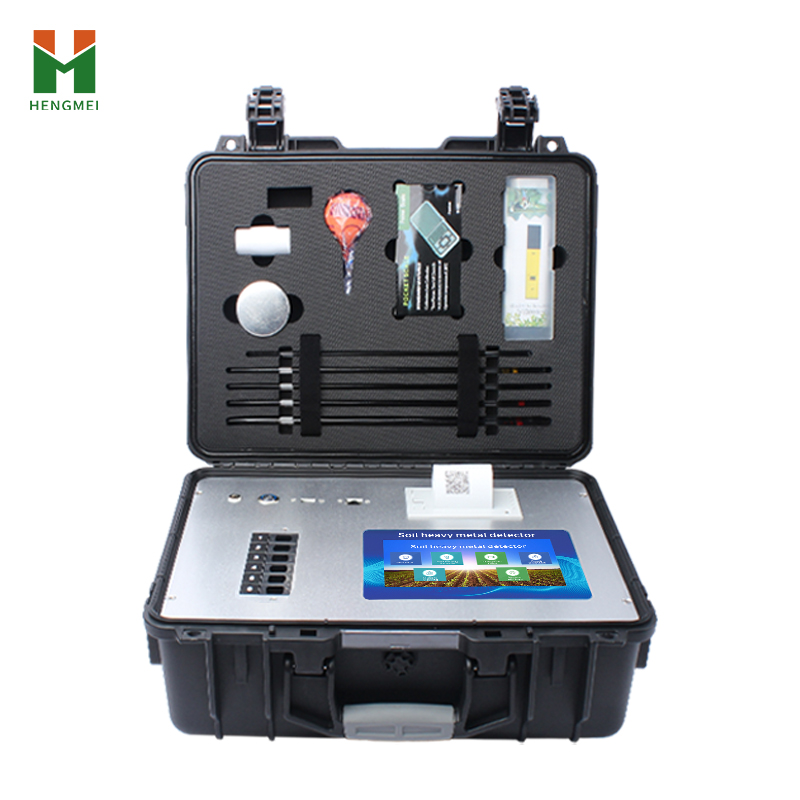With the rapid development of industry and agriculture, the problem of heavy metal pollution in soil is becoming increasingly prominent. The key to effectively preventing and controlling soil heavy metal pollution lies in quickly and accurately grasping the soil environmental quality status. The soil heavy metal detector integrates speed, portability, and efficiency to quickly detect heavy metal pollution in soil. It is an important on-site screening tool in environmental monitoring, agricultural safety, and other fields.

Technical principle: How to achieve rapid detection of heavy metals using photoelectric colorimetric method
The core detection principle of soil heavy metal detector is the photoelectric colorimetric method based on Lambert Beer law. The core of this method is that when a specific wavelength of monochromatic light passes through a colored solution, the substance to be measured in the solution will absorb the light, and its absorbance is proportional to the concentration of the substance.
The specific process for applying it to soil heavy metal detection is as follows:
1. Sample pretreatment (digestion and transformation): This is a prerequisite for the accuracy of detection. Soil samples undergo specific pre-treatment processes such as acid digestion to convert all forms of heavy metals (such as organic bound states and residual states) into measurable ionic forms.
2. Color reaction: Mix the processed sample solution with a specific heavy metal exclusive color reagent. Different heavy metal ions will undergo complexation reactions with corresponding reagents, generating colored complexes with varying shades of color and concentrations. For example:
Lead (Pb): Under weakly alkaline conditions, it forms a red complex with dithizone.
Cadmium (Cd): Under alkaline conditions, it forms a red complex with 6-bromophenylthiazolylazo naphthol.
Arsenic (As): It is reduced by potassium borohydride to produce arsine, which reacts with the absorption solution and turns yellow.
These methods strictly follow national standards (such as the GB/T5009 series), ensuring the authority and reliability of the methods.
3. Photoelectric detection: Inject the colored solution into the standard 1cm colorimetric dish of the instrument. The high-precision and long-life four wavelength cold light source (red, blue, green, orange) built into the instrument will emit the best wavelength beam suitable for the reaction to penetrate the solution. After the light is absorbed, the light signal is received by the sensor and converted into an electrical signal to calculate the absorbance value of the solution.
4. Intelligent calculation and result display: The instrument has pre stored the concentration absorbance standard curve established from the standard sample. During detection, the instrument automatically compares the measured absorbance value of the sample with the standard curve, instantly calculates the actual content of heavy metals in the sample (mg/kg), and directly displays it on a 7-inch high-definition touch screen.
The instrument adopts a 6-channel solid-state design, which allows simultaneous detection of 6 samples at once. Combined with intelligent constant current voltage stabilization and automatic light intensity calibration technology, it greatly improves the detection efficiency and accuracy of results.
Technical advantages and performance parameters
Detection efficiency and throughput: 6 independent detection channels, supporting batch detection; Fast detection speed (such as joint detection of lead, arsenic, chromium, cadmium, and mercury in about 60 minutes). Greatly improves the efficiency of sample screening, especially suitable for large-scale soil surveys, rapid safety assessments of agricultural product production areas, and other scenarios, significantly reducing the cost and time of single sample testing.
Testing performance and reliability: using a four wavelength cold light source, with a lifespan of 100000 hours and no temperature drift; Optical path positioning * * effectively shields external light interference. The stability and reproducibility of the test results are ensured, and the data is reliable, which can serve as a powerful basis for preliminary screening and decision-making.
Intelligence and usability: Android intelligent operating system, 7-inch true color touch screen; Built in pre-processing operation videos and plant nutrition diagnostic maps; Multi user permission management. The operation interface is intuitive and has strong guidance, greatly reducing the technical requirements for operators, and even beginners can quickly get started. Facilitating standardized laboratory management.
Data Management and Interconnection: Supports WiFi/4G/GPRS wireless data transmission to cloud platforms; Built in thermal printer, supporting QR codes; Export data through USB interface; GPS positioning. Realize real-time uploading, long-term storage, and visual analysis of detection data for easy traceability and supervision. The GPS function ensures accurate geographic information of sampling points, meeting the needs of modern environmental monitoring and management.
Portability and adaptability: AC/DC dual-use, built-in large capacity lithium battery; Design of high-strength PVC engineering plastic carrying case. The concept of "mobile laboratory" has been truly realized, which can be easily carried to the field, mining area, factory surroundings and other sites for real-time testing. It can work continuously for more than 10 hours when fully charged.
The soil heavy metal detector is an innovative product that deeply integrates classic photoelectric colorimetric analysis technology with modern intelligent and portable design concepts. Its efficient, accurate, convenient, and intelligent characteristics make it an important tool for achieving "source prevention and process strict management" in fields such as environmental monitoring and agricultural safety.
Article address:https://www.soiltesting.cn/news2/131.html






